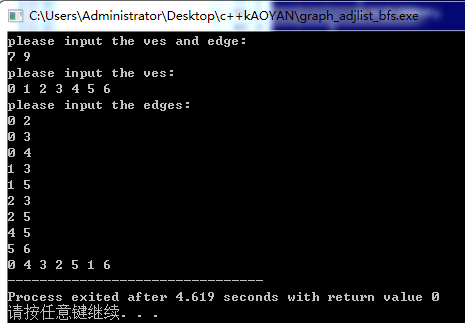图的广度优先遍历(邻接表)
#include<stdio.h> #include<stdlib.h> #include<string.h> #include<queue> using namespace std; #define MAX 100 typedef struct EdgeNode// 边表结点 { int adjves;//存储顶点的下标 struct EdgeNode* next;//连接下一个邻点 }EdgeNode; typedef struct VertexNode//顶点表结点 { int ves;//顶点的值 EdgeNode* firstedge;//相连的顶点的值 }VertexNode,AdjList[MAX]; //邻接表 typedef struct { AdjList adjlist; int ves;//顶点 int edge;//边 int book[MAX];//判断是否有被访问过 }MGraph; void createMGraph(MGraph *G) { int i; int start; int end; EdgeNode *e; printf("please input the ves and edge:\n"); scanf("%d%d",&(G->ves),&(G->edge)); //初始化 printf("please input the ves:\n");//此处设置顶点与存储下标相同且从零开始 for(i = 0; i < G->ves; i++)//输入顶点 { scanf("%d",&(G->adjlist[i].ves)); G->adjlist[i].firstedge = NULL; } //创建邻接矩阵 printf("please input the edges:\n"); for(i = 0; i < G->edge; i++) { scanf("%d%d",&start,&end); e =(EdgeNode*)malloc(sizeof(EdgeNode));//分配空间 e->adjves = end; e->next = G->adjlist[start].firstedge; G->adjlist[start].firstedge = e;//类似于链表的前插 e =(EdgeNode*)malloc(sizeof(EdgeNode));//分配空间 e->adjves = start; e->next = G->adjlist[end].firstedge; G->adjlist[end].firstedge = e;//类似于链表的前插 } } void bfs(MGraph *G,int ves) { queue<VertexNode> Q; Q.push(G->adjlist[ves]); G->book[ves] = 1; while(!Q.empty()){ VertexNode tmp = Q.front(); printf("%d ", tmp.ves); Q.pop(); EdgeNode *p = tmp.firstedge; while(p != NULL){ if(G->book[p->adjves] == 0){ Q.push(G->adjlist[p->adjves]); G->book[p->adjves] = 1; } p = p->next; } } } void bfsTraverse(MGraph *G){ int i; memset(G->book,0,sizeof(G->book));//清空标志位 for(i = 0; i < G->ves; i++) if(!G->book[i]) bfs(G, i); } int main() { MGraph G; createMGraph(&G); bfsTraverse(&G); return 0; } /* 输入样例: 7 9 0 1 2 3 4 5 6 0 2 0 3 0 4 1 3 1 5 2 3 2 5 4 5 5 6 */
输入样例:给定图如下

在关于bfs的代码编写的时候发现了自己 ->操作符和 .操作符乱用,下面作出说明:
比如你有这个结构体:
struct xx { int a; int b; }yy, *kk;
那么使用如下:
yy.a = 3, yy.b = 5; kk = new xx; kk->a = 4, kk->b = 6;
也就是说你用结构体定义了一个实体,那么这个实体要引用他里面的成员,就用.操作符
如果你用结构体定义的是一个结构指针,那么要引用他里面的成员就用->
typedef struct VertexNode//顶点表结点 { int ves;//顶点的值 EdgeNode* firstedge;//相连的顶点的值 }VertexNode,AdjList[MAX]; . . . void bfs(MGraph *G,int ves) { queue<VertexNode> Q; Q.push(G->adjlist[ves]); G->book[ves] = 1; while(!Q.empty()){ VertexNode tmp = Q.front(); printf("%d ", tmp.ves); Q.pop(); EdgeNode *p = tmp.firstedge; while(p != NULL){ if(G->book[p->adjves] == 0){ Q.push(G->adjlist[p->adjves]); G->book[p->adjves] = 1; } p = p->next; } } }
结合上述代码,VertexNode 结构体中定义了AdjList[MAX]实体数组
所以队列声明为 queue<VertexNode> Q; 而不是 queue<VertexNode*> Q;
所以类似声明 VertexNode tmp = Q.front();
继而 tmp 的相关操作使用操作符 .






 浙公网安备 33010602011771号
浙公网安备 33010602011771号